A Journey through States of Water Chapter Notes | Science Class 6 PDF Download
Introduction
Water is a clear, tasteless liquid that makes up most of our bodies and the Earth's surface. It's important because all living things need it to survive and stay healthy.

Are Ice and Water the Same Substance?
Yes, ice and water are two different forms, or states, of the same substance. This means that even though they look and behave differently, they are made of the same basic material.
For example:
- When water is in its liquid state, it can flow and take the shape of its container. It can also splash around.
- When water freezes and becomes ice, it becomes solid and does not flow. Ice can hold its shape and does not splash like water.
So, while ice and water behave differently, they are actually the same substance in different states.
Investigating Water's Disappearing Act
Can you explain where the water goes when we sprinkle it on a hot pan while making dosa and it disappears?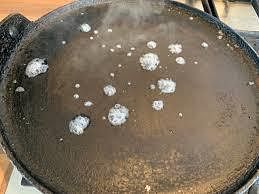
The water sprinkled on the hot pan gets converted into steam, which is actually water vapor. Some of this vapor condenses back into water droplets.

Evaporation: Water Turning into Vapor
- The process of converting water into its vapor state is called evaporation.
- Evaporation occurs continuously, even at room temperature.
- Examples include drying wet clothes, mopping the floor, and sweat evaporating from our body.
Reason for Water Disappearing from Puddles
Is it because of:
(i) water seeping into the ground,
(ii) evaporation of water, or
(iii) both.
Water Vapour in Steam
Water vapour is not visible on its own. However, when it condenses into tiny droplets of water, as seen in steam, it becomes visible.
Another Mystery
Can you explain why water droplets form on a cold water bottle when it's taken out of the fridge?
Water droplets form on the cold water bottle because water vapor in the air touches the cold surface and changes into liquid water. This process is called condensation.
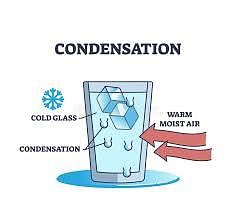
What is Condensation?
- The water droplets form because water vapor in the air comes into contact with the cold surface of the glass tumbler and condenses into liquid water. This process is known as condensation.
- For example, when warm, moist air from the plants cools down quickly, like on a cold glass or a leaf, the water vapor loses energy and changes back into liquid water. This is why you see water droplets on cold surfaces in the morning.
Understanding Humidity: A Yearly Study
- Humidity: Humidity refers to the amount of water vapor present in the air.
- Humidity Measured: The daily humidity levels in your area are measured and reported by newspapers and other sources.
- Study Humidity Data: By compiling the humidity data for the entire year, you can look for patterns and trends in how humidity changes throughout the seasons.
What are the Different States of Water?
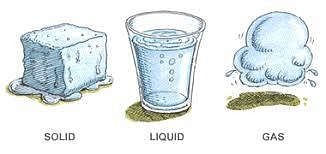
Water can be seen in three different states in our daily life: solid, liquid, and gas.
- Ice (Solid State): Ice keeps its shape no matter what container it is in. It does not flow or spread. For example stones, wood, and glass
- Water (Liquid State): Water takes the shape of its container, flows, and spreads. It has a constant volume but can change shape. Water can also spread while keeping its volume the same. For examples milk and oil.
- Water Vapour (Gaseous State): Water vapour spreads out to fill the entire space available. Gases do not have a fixed shape. Water vapour is present in the air around us, even at room temperature, although we cannot see it. It is produced when water evaporates, such as when clothes dry or floors are mopped. For example, oxygen and carbon dioxide
How can we Change the States of Water?
Can we change the state of water by adding or removing heat? If yes, how?
Yes, we can change the state of water by adding or removing heat. When we heat water, it turns into steam (gas). When we cool water, it turns into ice (solid). By changing the temperature, we can make water switch between liquid, gas, and solid states.
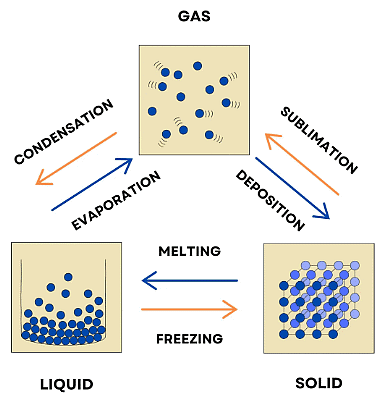
Let’s discuss melting and freezing:
- Melting: Melting is the process of changing from a solid state (ice) to a liquid state (water).
- Freezing: Freezing is the process of changing from a liquid state (water) to a solid state (ice).
What is an Atmospheric Water Generator (AWG) Machine?
- An Atmospheric Water Generator (AWG) machine is a device that produces drinkable water by collecting moisture from humid air.
- How Does it Work?: The AWG machine works by cooling the air, which causes the water vapor in the air to condense into liquid water. This process is similar to the way droplets of water form on the outside of a cold glass of ice water.
How can water be Evaporated Faster or Slower?
Can you explain why clothes dry faster on a windy day?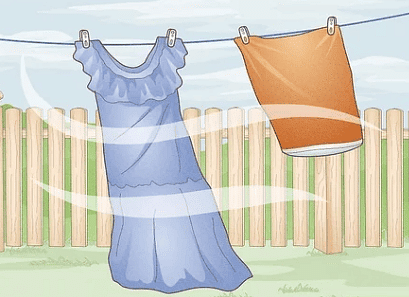
Clothes dry faster on a windy day because the moving air helps increase the rate of evaporation, making the water in the clothes evaporate more quickly.
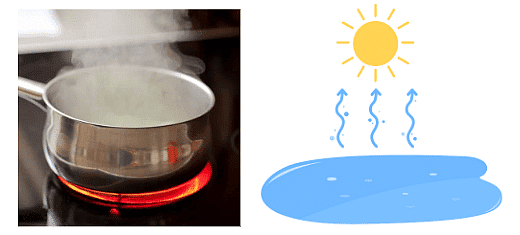
Factors affecting evaporation:
- Water evaporates faster with higher temperatures, wind, and a larger surface area.
- To slow down evaporation, we can lower the temperature, reduce airflow, and cover the surface of the water.
- These factors control how quickly water changes from liquid to gas.
Humidity on Rainy Days
- Humidity refers to the amount of water vapor present in the air.
- On rainy days, the air contains more water vapor, which increases humidity.
- This is why rainy days often feel more humid compared to dry days.
Cooling Effect of Evaporation
Can you explain why we feel cooler under a fan?
We feel cooler under a fan because the moving air helps evaporate sweat from our skin, which cools us down.
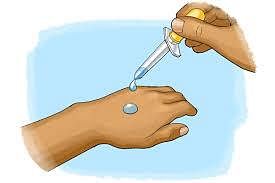
Cooling effect of evaporation
When water evaporates, it absorbs heat from its surroundings, causing a cooling effect. This phenomenon can be observed in various daily activities and objects.
Examples:
- Sweating: When we sweat, the evaporation of sweat from our skin takes away body heat, cooling us down.
- Earthen Pots: Water seeps through the porous surface of earthen pots and evaporates, keeping the stored water cool.
- Sprinkling Water: Sprinkling water on the floor or roof in summer can cool the area as the water evaporates.
How Do Clouds Give Us Rain?
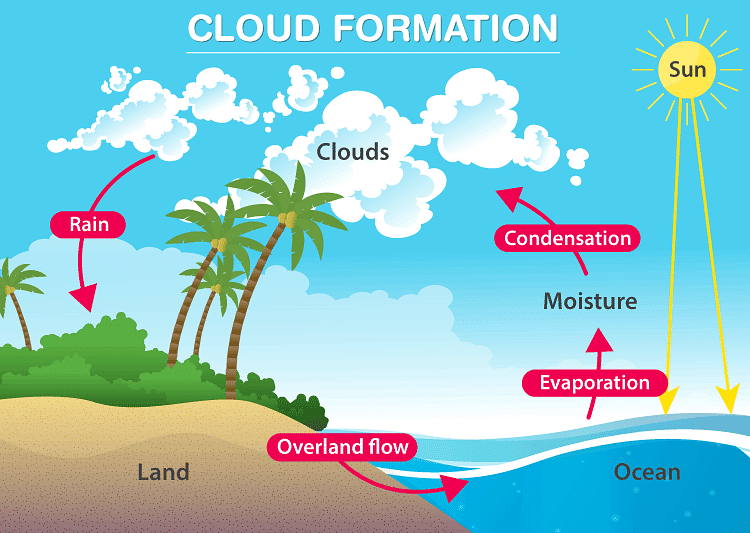
Role of Condensation in the Water Cycle
- Condensation is crucial for returning evaporated water to the Earth's surface.
- As air rises above the Earth's surface, it cools down. When the air cools to a certain point, the water vapor in it condenses into tiny droplets. These droplets usually form around dust particles.
- The tiny droplets gather together to form clouds. When these droplets combine and become larger, they eventually fall as rain.
Water Availability and Conservation
- A small portion of Earth's water is suitable for use by plants, animals, and humans. Most of the water is in the oceans and is not directly usable.
- Water is essential for drinking and various activities. With the rising population, the demand for water is increasing, leading to shortages in many areas.
- It is important to use water wisely, avoid wastage, and keep water bodies free from pollution.
Why Does Water Vapour in the Air Rise?
When air contains a lot of water vapour, it becomes lighter than the surrounding air. This is similar to how gas balloons filled with lighter gases rise in the atmosphere. The water vapour in the air makes it less dense, allowing it to rise higher in the atmosphere.
Key Points
- Evaporation: The process where liquid water changes into water vapour.
- Condensation: The process where water vapour changes back into liquid water.
- States of Water: Solid (ice), liquid (water), gas (water vapour).
- State Changes: Melting (solid to liquid), freezing (liquid to solid), evaporation (liquid to gas), condensation (gas to liquid).
- Factors Affecting Evaporation: Temperature, surface area, air movement, and humidity.
- Cooling Effect: Caused by the evaporation of water, taking heat from the surroundings.
- Cloud and Rain Formation: Through the condensation of water vapour and the combination of water droplets.
|
100 videos|261 docs|49 tests
|
FAQs on A Journey through States of Water Chapter Notes - Science Class 6
| 1. What are the three main states of water? |  |
| 2. How can we change water from one state to another? |  |
| 3. What factors can make water evaporate faster? |  |
| 4. How do clouds form and lead to rainfall? |  |
| 5. What is the cooling effect of evaporation? |  |

|
Explore Courses for Class 6 exam
|

|


















